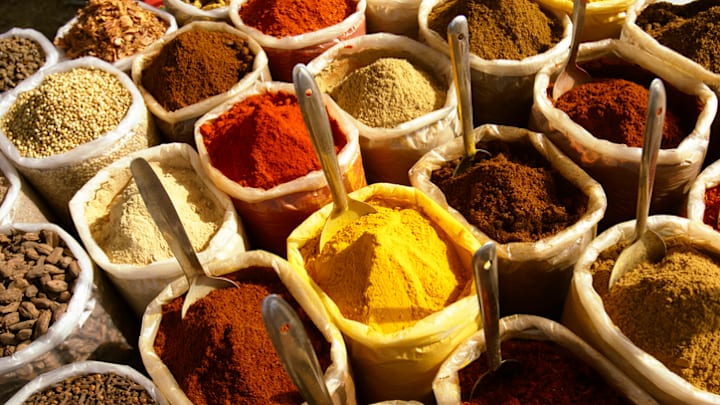The world’s lust for spices has shaped thousands of years of history. Let’s take a look at the origins of some of our favorite herbs and spices, from the ubiquitous salt to the more obscure horseradish, in this list adapted from the Mental Floss book In the Beginning: The Origins of Everything.
1. Pepper

If you eat enough pepper you’ll start to sweat, which explains why ancient peoples thought it made an excellent medical treatment. Chinese physicians employed it as a treatment for malaria, cholera, and dysentery, while Indian monks used it as a sort of PowerBar: they swallowed small amounts of pepper in hopes that it would help them survive their long treks through the rough countryside. Later, pepper became so valuable that it served as a de facto form of currency; it was used for centuries in Europe to pay rent and taxes.
In one exceptional case, it was also used for ransom. Attila the Hun is said to have demanded about 3000 pounds of pepper in 408 CE; in exchange, he promised to stop sacking the city of Rome.
2. Salt

It’s probably been the most valuable food additive in all of history, mostly because it did such a good job of preserving foods in the centuries before the refrigerator was invented. Salt mines in Chehr Abad, Iran, also testify to salt’s ability to preserve people. Four “salt men” have been discovered there, eerily mummified by what they were digging for, and two of them may date as far back as 650 BCE.
But the use of salt far predates the Iranian salt men. In China, 4700-year-old writings testify to its value; the Peng-Tzao-Kan-Mu, the earliest known treatise on pharmacology, mentions more than 40 kinds of salt. And a tragic piece of Chinese folklore tells a story of how the mythical phoenix first brought salt to the attention of a lowly peasant, who was accidentally put to death by a temperamental emperor before anyone realized the value of what he had found.
3. Cinnamon

Although it’s originally from Sri Lanka, cinnamon has been a global sensation for millennia. It first appears in Chinese writings from 2800 BCE (they called it kwai). Cinnamon was also used by ancient Egyptian embalmers, perhaps for the same reason that it became a popular cooking spice—its warm aroma and antibacterial properties could hide the stench of meat starting to go bad.
More Stories About Food History
Romans had attachments to cinnamon that were both medical and sentimental. Pliny the Elder records cinnamon as being worth about 15 times its weight in silver. And the Roman Emperor Nero, known for both his evil tendencies and his extravagance, sacrificed a year’s supply of cinnamon as punishment for murdering his wife.
4. Nutmeg

Like cinnamon, this one’s been a popular spice since the days of, yep, Pliny the Elder. He wrote about a curious plant that bears two spices: nutmeg (its seed) and mace (the reddish covering around the seed). Nutmeg’s distinctive scent has made it consistently popular through the ages; the Holy Roman Emperor Henry VI reportedly had workers blanket Roman streets with the aroma in celebration of his crowning.
The majority of the world’s nutmeg now comes from the Caribbean island of Grenada—in fact, the local economy is based almost entirely on tourism and nutmeg exports, and the spice is the centerpiece of the country’s flag. But nutmeg didn’t even exist in Grenada until British sailors brought it there from Indonesia in the early 1800s.
5. Ginger

Marco Polo didn’t bring back pasta from his trip to China, but he did reintroduce ginger to Europe. Hugely popular in the Roman Empire, ginger suffered roughly the same fate as that empire: By Polo’s day, it was barely remembered by European cooks. After Polo and company imported it as a rare luxury, it stayed that way for centuries; Queen Elizabeth I was a noted enthusiast. Some historians think she may have popularized the gingerbread man.
6. Horseradish

Anything that tastes as strong as horseradish must have a history of use in medicine. In the 3500 years humans have been eating it, people have treated everything from rheumatism to tuberculosis, lower back pain to low libido with horseradish. Hippocrates wrote about it (along with the 400 other spicy medicines he recommended). The Oracle at Delphi was a big fan, too; it supposedly told Apollo that “the radish is worth its weight in lead, the beet its weight in silver, and the horseradish its weight in gold.”
Horseradish had a bit of a renaissance during, well, the Renaissance. As a food fad, it spread all over Europe and Scandinavia, and by the late 1600s, it was a British staple, eaten alongside beef and oysters and made into pungent cordials.
You may be wondering why it’s called horseradish. The answer has very little to do with horses. Germans called the root meerrettich, or “sea radish,” since the herb grows wild in coastal areas. English speakers may have picked up the word as mare-radish, which then became the genderless horseradish. American settlers had an even more evocative name for it: stingnose.
A version of this story was published in 2009; it has been updated for 2024.
